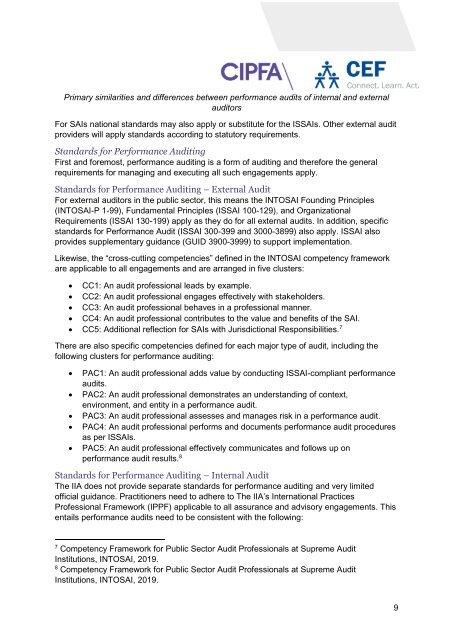Create successful ePaper yourself
Turn your PDF publications into a flip-book with our unique Google optimized e-Paper software.
Primary similarities and differences between performance audits of internal and external<br />
audi<strong>to</strong>rs<br />
For SAIs national standards may also apply or substitute for the ISSAIs. Other external audit<br />
providers will apply standards according <strong>to</strong> statu<strong>to</strong>ry requirements.<br />
Standards for <strong>Performance</strong> <strong>Audit</strong>ing<br />
First and foremost, performance auditing is a form of auditing and therefore the general<br />
requirements for managing and executing all such engagements apply.<br />
Standards for <strong>Performance</strong> <strong>Audit</strong>ing – External <strong>Audit</strong><br />
For external audi<strong>to</strong>rs in the public sec<strong>to</strong>r, this means the INTOSAI Founding Principles<br />
(INTOSAI-P 1-99), Fundamental Principles (ISSAI 100-129), and Organizational<br />
Requirements (ISSAI 130-199) apply as they do for all external audits. In addition, specific<br />
standards for <strong>Performance</strong> <strong>Audit</strong> (ISSAI 300-399 and 3000-3899) also apply. ISSAI also<br />
provides supplementary guidance (GUID 3900-3999) <strong>to</strong> support implementation.<br />
Likewise, the “cross-cutting competencies” defined in the INTOSAI competency framework<br />
are applicable <strong>to</strong> all engagements and are arranged in five clusters:<br />
CC1: An audit professional leads by example.<br />
CC2: An audit professional engages effectively with stakeholders.<br />
CC3: An audit professional behaves in a professional manner.<br />
CC4: An audit professional contributes <strong>to</strong> the value and benefits of the SAI.<br />
CC5: Additional reflection for SAIs with Jurisdictional Responsibilities. 7<br />
There are also specific competencies defined for each major type of audit, including the<br />
following clusters for performance auditing:<br />
<br />
<br />
<br />
<br />
<br />
PAC1: An audit professional adds value by conducting ISSAI-compliant performance<br />
audits.<br />
PAC2: An audit professional demonstrates an understanding of context,<br />
environment, and entity in a performance audit.<br />
PAC3: An audit professional assesses and manages risk in a performance audit.<br />
PAC4: An audit professional performs and documents performance audit procedures<br />
as per ISSAIs.<br />
PAC5: An audit professional effectively communicates and follows up on<br />
performance audit results. 8<br />
Standards for <strong>Performance</strong> <strong>Audit</strong>ing – Internal <strong>Audit</strong><br />
The IIA does not provide separate standards for performance auditing and very limited<br />
official guidance. Practitioners need <strong>to</strong> adhere <strong>to</strong> The IIA’s International Practices<br />
Professional Framework (IPPF) applicable <strong>to</strong> all assurance and advisory engagements. This<br />
entails performance audits need <strong>to</strong> be consistent with the following:<br />
7<br />
Competency Framework for Public Sec<strong>to</strong>r <strong>Audit</strong> Professionals at Supreme <strong>Audit</strong><br />
Institutions, INTOSAI, 2019.<br />
8<br />
Competency Framework for Public Sec<strong>to</strong>r <strong>Audit</strong> Professionals at Supreme <strong>Audit</strong><br />
Institutions, INTOSAI, 2019.<br />
9
















